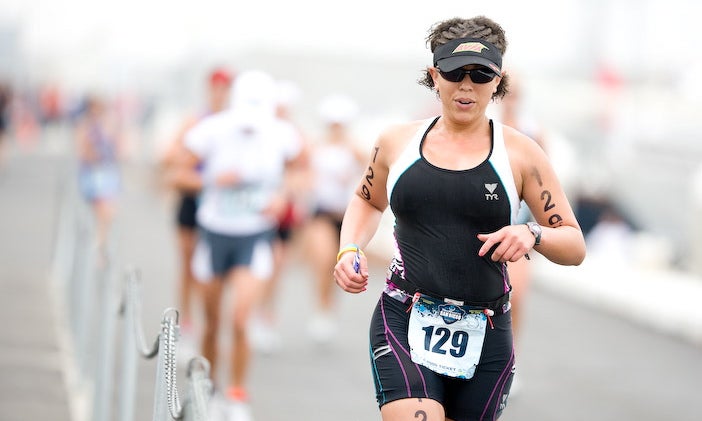Race With A Happy Tummy

Getting to the finish line with a content stomach is a major hurdle. Photo: John Segesta
Experts provide new tips on preventing gastrointestinal distress during triathlons and other intense exercise.
Of all the reasons to fall short of one’s goal in a triathlon, stomach upset has to be among the worst. I don’t know about you, but I would rather be able to blame a poor performance on inadequate training or bad weather that slowed everyone else down too than to know my lungs and legs were up to the challenge but my tummy was not.
Gastrointestinal issues are very common during triathlons. A study published recently in the journal Medicine & Science in Sports & Exercise reported that serious GI symptoms were experienced by 31 percent of Ironman triathletes and 14 percent of Ironman 70.3 racers. That’s a lot of frustrated triathletes!
What can you do to ensure that you are not among that 31 percent or 14 percent in your next event? Brazilian researchers have published a new review on the problem of GI distress in exercise that offers some answers.
Authors Erick de Oliveira and Roberto Burini begin their paper by stating that the common signs and symptoms of GI distress experienced during exercise, including stomach discomfort, stomach cramps, stomach bloating, gas, vomiting, and diarrhea, are typically caused by a combination of strenuous exercise itself and the effects of nutrition consumed during exercise. It is possible to suffer GI stress during exercise without consuming any nutrition. It’s also possible to inflict stomach cramps and such upon yourself by eating too much or eating the wrong thing outside of exercise. But the likelihood of problems occurring is magnified when strenuous exercise and nutrition intake are combined.
Obviously, there’s not much you can do about the exercise part of the equation. When you’re competing in a triathlon your goal is to reach the finish line as quickly as you can, and you’re not about to slow down just to take it easy on your stomach. So what can be done about the nutritional side of the equation?
De Oliveira and Burini enumerate three specific nutrition-related causes of GI distress during exercise: dehydration, delayed gastric emptying, and gut ischemia (or lack of adequate oxygen supply to the gut).
Regarding dehydration, De Oliveira and Burini refer to a previous experiment which found that runners suffered GI distress during running only when they were dehydrated. Other experiments have turned up similar results. The reason appears to be that dehydration slows the emptying of the stomach’s contents, and it’s the jostling of these contents that often causes symptoms such as nausea. The irony here is that if you avoid drinking during running to minimize your stomach’s contents, you also exacerbate dehydration, while if you drink to minimize dehydration, you fill your stomach with material that can be jostled around. Since you have to drink to prevent dehydration itself from ruining your performance, your best bet is to “go all the way” and drink enough to minimize both dehydration and its negative effect on stomach emptying.
Too much is just as much of a problem as too little, however. Very high rates of fluid intake increase the risk of GI distress. Consuming fluids that are too nutrient-concentrated has the same effect. The typical sports drink has a carbohydrate concentration of 6 percent and an osmolality (or total particle concentration) of roughly 325. De Oliveira and Burini point out that drinking beverages with a higher carbohydrate concentration or osmolality has been shown to make stomach problems more likely. This means you should save your favorite convenience-store “energy drink” for after the race!
When you start adding nutrients beyond the water, sodium, and carbs contained in sports drinks into your triathlon nutrition plan, you really start asking for trouble (that is, GI trouble), say these authors. They point to one study in which “an association was reported between nutritional practices and GI complaints during a half ironman-distance triathlon with the intake of fiber, fat, protein and concentrated carbohydrate solutions during the triathlon, in particular beverages with very high osmolality.”
This doesn’t mean you have to avoid semisolids and solids entirely in races, but it does mean you should use only products made specifically for use during exercise (e.g. energy gels and bars); and if you do use them, you need to wash them down with enough water to keep the overall nutrient concentration of your stomach contents from getting too high and thus slowing stomach emptying, causing GI distress, and ruining your race.
*
Matt Fitzgerald is the author of Iron War: Dave Scott, Mark Allen & The Greatest Race Ever Run (VeloPress 2011) and a Coach and Training Intelligence Specialist for PEAR Sports. Find out more at Mattfizgerald.org.